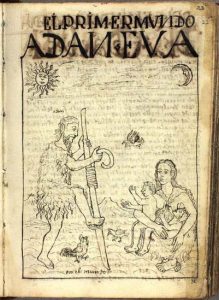The conversation we had on Monday about how to define indigeneity brought up many interesting points of view and ways to approach the definition itself or reasons we should back away from applying it at all. One theme that stuck out to me in the discussion and in the reading of “Primer nueva crónica y buen gobierno” was the idea of Sameness and Otherness.
A few people made the argument that using the term indigenous was an imposed colonial (or post-colonial) way of creating an “other”, anything that isn’t part of the colonial regime could be grouped under “indigenous”. A way to categorize an entire pre-existing society of people into a singular, culturally defined box. Some people also proposed that “indigenous” is a term used from within to identify a sameness. A way to gather various voices together and identify under a shared experience which binds otherwise disparate together in a specific way.
In the reading, Guaman Poma also seems to use Otherness and Sameness as a means to an end. It seems to us, Pomas’ objective was most likely to advocate for the improved treatment of the indigenous (Incan) peoples under colonial rule by appealing to the theistic soft-spot of the King. He accomplishes this by Othering the Spanish soldiers from the wishes of the King himself and highlighting the Sameness that the indigenous people have to the Spanish subjectives.
Poma goes about Othering by highlighting the conquistadors’ fall into temptation – Greed. Using a religiously-backed appeal, he implies that the Spanish conquistadores must be Other to the righteous king himself and therefore not loyal to the wishes or mission of the Spanish.
The implication of sameness can be seen illustrated by the similarities in the drawings of “Adam and Eve” and “The First Generations of Indians Wari Wiracocha Runa” (Poma, 14 and 28).


Both images depict the first people of the respective cultures. Represented is man and woman, working together to sow the land and create life for the continuation of the population. Poma emphasizes the continuous blood lines, which were of importance in Spain, running from Adam/Eve through to Noah and down into the Wari people of now-called Peru, “these were the ones who
left Noah’s ark following the flood, and who multiplied, by God’s command, and filled the world (25). Poma engenders Sameness between the Spanish and the indigenous not just at the level of culture but of shared genetic ancestry, shared Biblical ancestry. He also makes efforts to highlight the religious and non-idolatrous practices of the pre-Incan cultures to emphasize that there is a true “Christian spirit” within them. He even goes as far to say, Christian readers, about these new people! Learn from them how to show faith and service for God, the Most Holy Trinity (27).
I think there’s merit in seeing “indigentity” as a term effective in both capacities but what’s inarguable to me is that the concept itself seems to have been used for a long time as a bargaining chip to get something out of someone.
- What position do you take on the effect of the term “indigenous”?
- Is identification with a specific term in order to accomplish a goal (whether from the inside or out) an inherently flawed use of an identity? Or is it the purpose of identifying a group to begin with?
4 replies on “Use of “othering” and “sameness” by Guaman Poma”
Hi Morgan! You highlighted some very interesting points that were discussed in our class, kudos to you for taking great notes and listening intently! Indigeneity to me (as you know from our class discussion) is an imposed label that describes the people and culture that came before settlers and colonialists. I enjoyed reading your analysis of how Poma creates a sense of sameness between the Spaniards and the indigenous groups.
Hey Morgan, fantastic post. I found you pointing out Poma’s use of ‘otherization’ and ‘sameness’ very insightful, and is an interestingly conflicting fact with the nature of the colonial (and post-colonial) tactics that I’m familiar with. In terms of how I view the term “Indigeneity”, I am actually feeling quite concerned about the effects of us discussing it and categorizing it in any way. This is especially compounded by the somewhat abstract framework we’ve been using, which feels sort of colonial in and of itself.
“He accomplishes this by Othering the Spanish soldiers from the wishes of the King himself and highlighting the Sameness that the indigenous people have to the Spanish subjectives.” This is an important insight. The political community of that time was based on belonging to the Catholic faith and subjection to the Monarch. By defending greater loyalty from the indigenous people than from the imperfect Spaniards, we realize that the merely racial aspect is not defining to create hierarchies in that Old Regime. In fact, as in another of the illustrations in Guamán Poma’s book, it changes the relationship between Cusco and Madrid.
Hi Morgan, I really enjoyed reading your insights! Your points on Sameness and Otherness especially give me a lot to think about…particularly about how these can be strategically positioned to accomplish a goal or to appeal…thanks for your post! 🙂